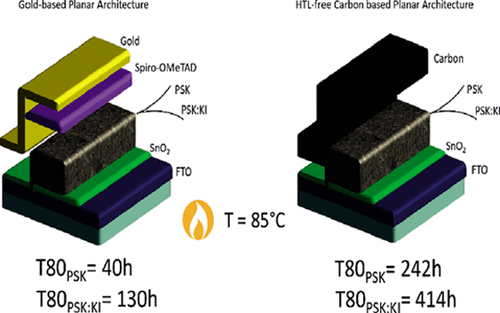当前位置:
X-MOL 学术
›
ACS Appl. Mater. Interfaces
›
论文详情
Our official English website, www.x-mol.net, welcomes your feedback! (Note: you will need to create a separate account there.)
Easy Strategy to Enhance Thermal Stability of Planar PSCs by Perovskite Defect Passivation and Low-Temperature Carbon-Based Electrode.
ACS Applied Materials & Interfaces ( IF 9.5 ) Pub Date : 2020-06-26 , DOI: 10.1021/acsami.0c05878 Emanuele Calabrò 1 , Fabio Matteocci 1 , Barbara Paci 2 , Lucio Cinà 3 , Luigi Vesce 1 , Jessica Barichello 1 , Amanda Generosi 2 , Andrea Reale 1 , Aldo Di Carlo 1, 2, 4
ACS Applied Materials & Interfaces ( IF 9.5 ) Pub Date : 2020-06-26 , DOI: 10.1021/acsami.0c05878 Emanuele Calabrò 1 , Fabio Matteocci 1 , Barbara Paci 2 , Lucio Cinà 3 , Luigi Vesce 1 , Jessica Barichello 1 , Amanda Generosi 2 , Andrea Reale 1 , Aldo Di Carlo 1, 2, 4
Affiliation

|
Organic–inorganic lead halide perovskite has recently emerged as an efficient absorber material for solution process photovoltaic (PV) technology, with certified efficiency exceeding 25%. The development of low-temperature (LT) processing is a challenging topic for decreasing the energy payback time of perovskite solar cell (PSC) technology. In this context, the LT planar n–i–p architecture meets all the requirements in terms of efficiency, scalability, and processability. However, the long-term stability of the LT planar PSC under heat and moisture stress conditions has not been carefully assessed. Here, a detailed study on thermal and moisture stability of large-area (1 cm2) LT planar PSCs is presented. In particular, the key role in thermal stability of potassium iodide (KI) insertion in the perovskite composition is demonstrated. It is found that defect passivation of triple-cation perovskite by KI doping inhibits the halide migration induced by thermal stress at 85 °C and delays the formation of degradation subproducts. T80, defined as the time when the cell retains 80% of initial efficiency, is evaluated both for reference undoped devices and KI-doped ones. The results show that T80 increases 3 times when KI doping is used. Moreover, an HTL-free architecture where the Au top electrode is replaced with low-T screen-printable carbon paste is proposed. The combination of the carbon-based HTL-free architecture and KI-doped perovskite permits T80 to increase from 40 to 414 h in unsealed devices.
中文翻译:

通过钙钛矿缺陷钝化和低温碳基电极增强平面PSC的热稳定性的简便策略。
有机-无机卤化铅钙钛矿最近已成为溶液法光伏(PV)技术的高效吸收材料,经认证的效率超过25%。低温(LT)处理的发展对于减少钙钛矿太阳能电池(PSC)技术的能量回收时间是一个具有挑战性的主题。在这种情况下,LT平面n–ip结构满足了效率,可伸缩性和可加工性方面的所有要求。但是,尚未仔细评估LT平面PSC在热和湿应力条件下的长期稳定性。在这里,对大面积(1 cm 2)提出了LT平面PSC。特别地,证明了钙钛矿组合物中碘化钾(KI)插入的热稳定性中的关键作用。发现通过KI掺杂对三阳离子钙钛矿的缺陷钝化抑制了在85℃下由热应力引起的卤化物迁移并延迟了降解副产物的形成。T 80定义为电池保持初始效率的80%的时间,同时针对参考无掺杂器件和KI掺杂器件进行评估。结果表明,当使用KI掺杂时,T 80增加3倍。此外,提出了一种无HTL的架构,其中Au顶电极被低T丝网印刷的碳糊替代。碳基无HTL架构与KI掺杂钙钛矿的结合在未密封的设备中,T 80从40 h增加到414 h。
更新日期:2020-07-22
中文翻译:

通过钙钛矿缺陷钝化和低温碳基电极增强平面PSC的热稳定性的简便策略。
有机-无机卤化铅钙钛矿最近已成为溶液法光伏(PV)技术的高效吸收材料,经认证的效率超过25%。低温(LT)处理的发展对于减少钙钛矿太阳能电池(PSC)技术的能量回收时间是一个具有挑战性的主题。在这种情况下,LT平面n–ip结构满足了效率,可伸缩性和可加工性方面的所有要求。但是,尚未仔细评估LT平面PSC在热和湿应力条件下的长期稳定性。在这里,对大面积(1 cm 2)提出了LT平面PSC。特别地,证明了钙钛矿组合物中碘化钾(KI)插入的热稳定性中的关键作用。发现通过KI掺杂对三阳离子钙钛矿的缺陷钝化抑制了在85℃下由热应力引起的卤化物迁移并延迟了降解副产物的形成。T 80定义为电池保持初始效率的80%的时间,同时针对参考无掺杂器件和KI掺杂器件进行评估。结果表明,当使用KI掺杂时,T 80增加3倍。此外,提出了一种无HTL的架构,其中Au顶电极被低T丝网印刷的碳糊替代。碳基无HTL架构与KI掺杂钙钛矿的结合在未密封的设备中,T 80从40 h增加到414 h。


























 京公网安备 11010802027423号
京公网安备 11010802027423号